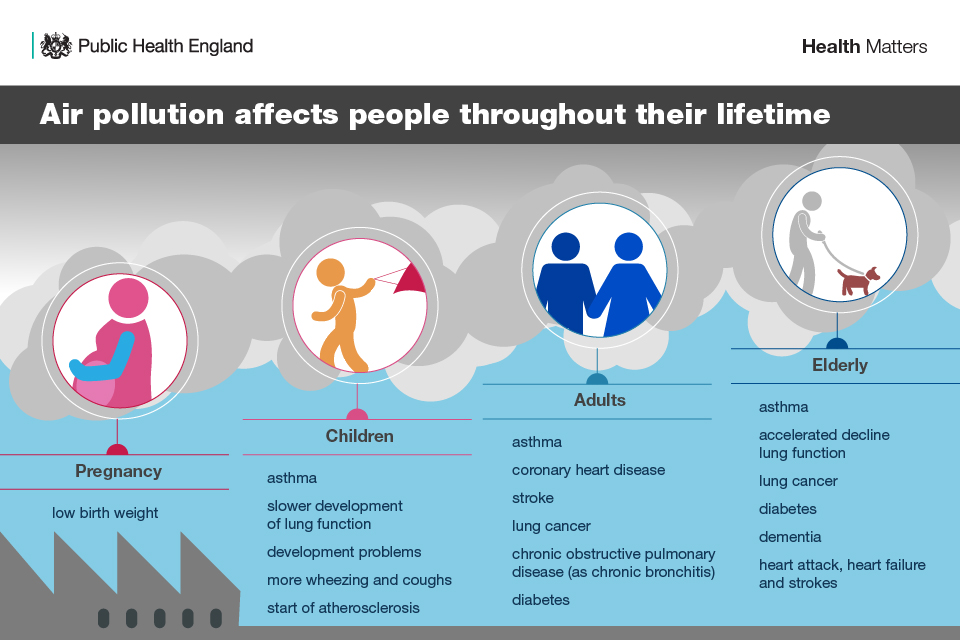What is air pollution and what are the risks?
When referring to ‘good’ or ‘poor’ air quality, we are referring to how exposure to the air affects someone’s health. Increased air pollution decreases air quality and can negatively impact a person’s health.
Air pollution is the number one environmental health risk worldwide, according to the World Health Organization (WHO). It is attributed to the premature death of around 7 million people around the world and estimates show that the cost of air pollution-related healthcare could reach £127.5 billion by 2060.
Air pollutants are varied in nature (particles as small as a micron or gas to as big as a grain of sand), and can be emitted as a result of human activities or they can be naturally occurring—indoors and out.
Air pollution can affect everyone, and air in all areas of the UK contains some proportion of man-made air pollutants. Exposure to air pollution has various different health effects, which come about at every stage of life, from a foetus’ first weeks in the womb all the way through to old age. The health effects of air pollution are complex, and range in severity of impact. In some cases, damage can be gradual and may not become apparent for many years.
Air pollution is the number one environmental health risk worldwide, according to the World Health Organization (WHO). It is attributed to the premature death of around 7 million people around the world and estimates show that the cost of air pollution-related healthcare could reach £127.5 billion by 2060.
Air pollutants are varied in nature (particles as small as a micron or gas to as big as a grain of sand), and can be emitted as a result of human activities or they can be naturally occurring—indoors and out.
Air pollution can affect everyone, and air in all areas of the UK contains some proportion of man-made air pollutants. Exposure to air pollution has various different health effects, which come about at every stage of life, from a foetus’ first weeks in the womb all the way through to old age. The health effects of air pollution are complex, and range in severity of impact. In some cases, damage can be gradual and may not become apparent for many years.

What is this project all about?
We used portable air quality monitors to measure a selection of pollutants over four years across St Andrews. We wanted to be able to identify hotspots of high pollution and assess the general air quality in St Andrews. Air quality is currently monitored at a few roadside locations by Fife Council; our data complements this by covering even the quieter streets of St Andrews.
We found that air quality in St Andrews is generally good. All the pollutants we assessed fell within the Scottish Air Quality Objectives and all but nitrogen dioxide fell within the WHO Air Quality Guidelines.
Road traffic is the single biggest emitter of air pollution in St Andrews however, some pollutants can be transported long distances on the wind and therefore may be polluting the air in St Andrews but were not emitted here.
The full report can be accessed below.
We found that air quality in St Andrews is generally good. All the pollutants we assessed fell within the Scottish Air Quality Objectives and all but nitrogen dioxide fell within the WHO Air Quality Guidelines.
Road traffic is the single biggest emitter of air pollution in St Andrews however, some pollutants can be transported long distances on the wind and therefore may be polluting the air in St Andrews but were not emitted here.
The full report can be accessed below.
What can you do to improve your local air quality?
More information
For more detailed information on air quality in St Andrews see the full report produced by Transition St Andrews:
To protect yourself from poor air quality, you can set up alerts at https://www.scottishairquality.scot/ so you can plan and avoid exposure on days of poor air quality.
For more information about the monitoring and distribution of air quality in Fife see https://www.fife.gov.uk/air-quality
Get involved!
If you want to get involved or do some air quality monitoring of your own, contact us and we can provide you with the necessary tools!




